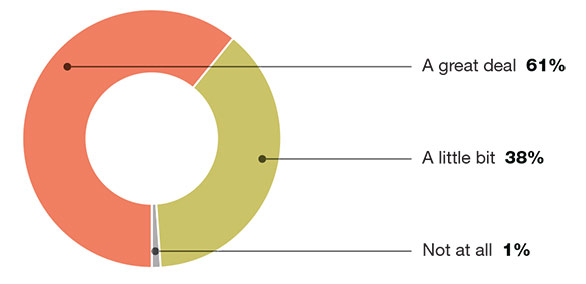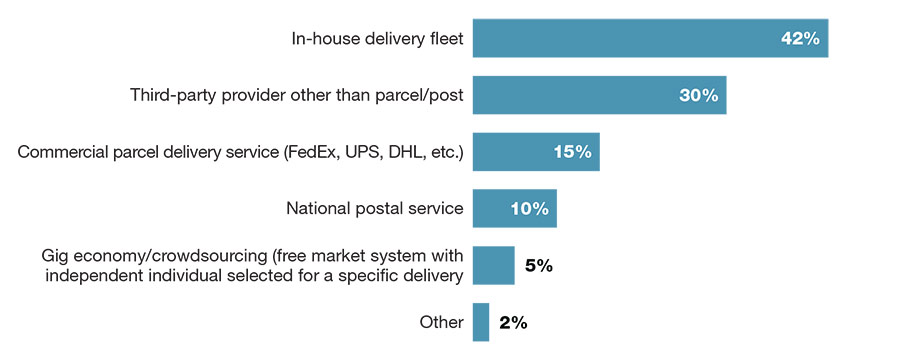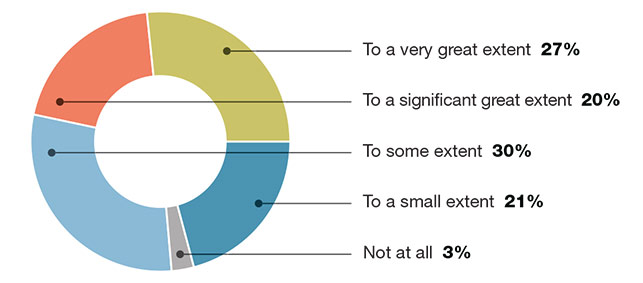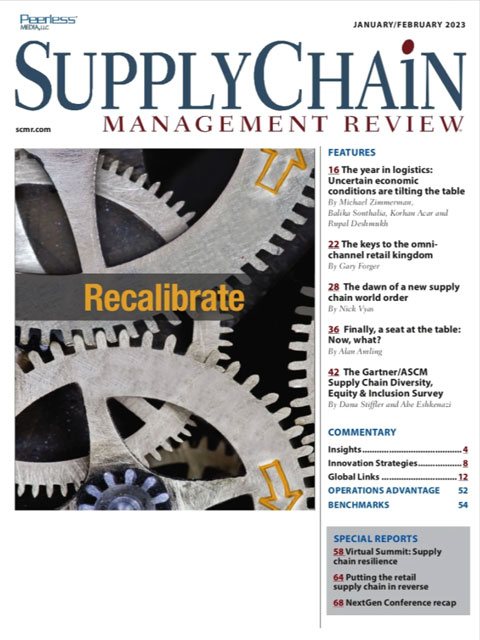Sorry, but your login has failed. Please recheck your login information and resubmit. If your subscription has expired, renew here.
January-February 2023
It feels like a normal holiday season. ”That was the report I got from the VP of global distribution at one of the country’s best known retail brands on the Monday before Black Friday. He added that the last time he felt that way was November of 2019. One of the perks of this job is that I get to talk to a lot of supply chain executives. In my conversations over the last year, I’ve learned two things. Operations, which was perhaps hardest hit at the start of the pandemic, has learned to operate in this new environment. Sure, there are still hiccups caused by absenteeism and inventory shortages. But those are situational—give them supply and… Browse this issue archive.Need Help? Contact customer service 847-559-7581 More options
Markets have seen numerous shifts in consumer behavior as a result of the COVID-19 pandemic. Many organizations have noted an increased demand by consumers for faster order delivery and more visibility into order processing. APQC recently conducted research into customer behavior to quantify the changes noted by companies.
As shown in Figure 1, the expectations of consumers are creeping into the expectations of business customers, with nearly 70% of organizations reporting that their B2B customers have the same expectations as B2C customers. Organizations have also noticed an increase in online orders, as well as less patience among customers for delays or poor visibility into orders.
The changes in expectations among both businesses and consumers have placed greater importance on last-mile logistics, during which a product is delivered to its final destination (often a store or customer location). Since the start of the pandemic, the last mile has focused more on the delivery of products to consumers’ homes as online shopping increased.
Click here to view the related infographic from APQC
Changes in customer behavior and expectations have made an impact on organizations’ costs. As shown in Figure 2, 61% of those surveyed by APQC report that changes in customer behavior have made a great impact on their cost to serve, profitability and ability to fulfill orders in a timely manner. Only 1% of organizations say that their costs have not been affected at all.
Figure 1: Changes in customer behavior due to pandemic

Source: APQC
These results highlight the key roles that timely delivery and order visibility play in customer satisfaction. For better or worse, organizations must prioritize improvements to last-mile delivery. Customer service and product offerings pale in comparison to the importance of orders arriving on time as promised.
APQC’s research into last-mile delivery indicates that organizations have room to improve the delivery experience for their customers. Technology developments offer the prospect of enhanced visibility and efficiency, but organizations should consider other improvement options as well.
Figure 2: Impact of changes in customer behavior on cost to serve, profitability and ability to fulfill orders in a timely manner

Source: APQC
Methods of last-mile delivery
APQC collected performance data from more than 1,100 organizations through its Open Standards Benchmarking in Logistics. Analyzing this data, APQC looked at how organizations approach their last-mile deliveries. As shown in Figure 3, there is no clear leader among the methods organizations use.
The most common method used is an in-house delivery fleet. To ensure greater control of their last-mile deliveries, some organizations rely on their own fleet of delivery vehicles. They may also use a hybrid method of their own vehicles, third-party providers and gig delivery drivers to ensure maximum availability. This presents its own challenges as tracking the various parties involved in deliveries can be difficult.
Figure 3: Method of last mile delivery
(Median values)

Many organizations rely on third-party providers that are not a traditional commercial parcel delivery service or the national postal service. Although 25% of organizations use services such as FedEx, UPS and the postal service, these providers have faced their own difficulties in delivering packages on time and in a cost-effective manner. Some major companies have leveraged the size of their logistics networks to provide shipping services to outside brands, offering another option to organizations needing delivery resources.
Five percent of organizations report relying on the gig economy or crowdsourcing for their last-mile deliveries. This can ensure timely delivery as having a variety of independent providers means that there can be a vehicle available whenever the company needs one. However, there are tradeoffs to this method. The independent nature of the drivers means that companies have less visibility into the status of a package. There is also some risk that a delivery still may not arrive on time or in the manner anticipated by the customer.
Visibility: It’s a problem
Savvy customers now have less patience for limited visibility into the status of their orders. Figure 4 shows the extent to which organizations’ customers can see real-time order status through to the last mile of delivery. Nearly half of the organizations in APQC’s data enable customers’ visibility to a very great or significant extent (47%). More than half do so to some extent or to a small extent (51%)—resulting in these customers having much less visibility into orders during the last mile.
Customer expectations have only increased since the start of the pandemic. It is no longer enough for companies to offer fast, free shipping; customers also expect to know where their orders are from the moment of shipment to the moment the package arrives at its destination. All of this leads to substantial costs, both for shipping overall and for the last-mile delivery in particular.
Support from technology
Organizations have numerous new technologies to consider when seeking to improve their last-mile deliveries. Much attention has been paid to delivery technologies such as autonomous vehicles, delivery drones and delivery robots. Although these have not yet been widely adopted, the underlying technology has advanced quickly and is worth tracking by organizations for future investment.
Organizations can also adapt existing technology. For example, GPS and RFID tags have enabled companies to enhance the visibility of their supply chain for their customers. Organizations have also adopted route planning software to increase the efficiency of their in-house fleets and speed up deliveries.
Figure 4: Extent to which customer visibility of real-time status extends into the last-mile of delivery

Source: APQC
Organizations can use analytics to their advantage to counteract the rising costs of shipping. If they have existing analytics functions, these can focus on identifying and applying changes that can reduce costs associated with internal processes. This will enable the company to reduce costs where it can without reducing the service levels expected by customers.
Organizations need not rely only on their technology capabilities to enhance last-mile deliveries. They can partner with 3PLs that have the infrastructure needed to optimize shipping. A third-party provider with an advanced warehouse and inventory management system can both speed up deliveries and reduce cost to the company.
Focus on variety
The demands of customers have caused organizations to scramble to ensure timely deliveries with a high degree of visibility. Technologies can support an organization to meet its logistics needs while addressing the costs associated with last-mile deliveries. However, these are not the only tools
organizations can use.
They can examine their warehouse locations to determine whether additional space would be a cost-effective way to deliver orders to the largest number of customers using the shortest timeline. For example, they can reduce the distance a package travels in urban areas by increasing the number of their warehouses in cities. This can reduce shipping costs up front and get orders to customers faster, as soon as same day or next day in many instances.
Organizations need not rely on traditional warehouses. Some organizations are embracing micro warehousing, in which a company rents additional space, most likely in an urban area, and dedicates each space to specific types of deliveries. This flexible solution enables businesses to distribute inventory at locations in which demand is highest.
They can also leverage their existing business relationships to gain greater visibility into shipments. They can develop data sharing agreements with partners to identify and facilitate lower cost shipping options. The agreements allow the parties to share key types of data that enable more accurate demand planning based on recent customer behavior and translate that into fleet strategy.
Organizations are having to be more creative with ensuring deliveries meet the expectations of customers. Through a combination of technology adoption, resourceful shipping decisions, and new ways of using existing relationships, they can develop new ways to address complex shipping needs and last-mile deliveries.
About APQC
APQC helps organizations work smarter, faster, and with greater confidence. It is the world’s foremost authority in benchmarking, best practices, process and performance improvement, and knowledge management. APQC’s unique structure as a member-based nonprofit makes it a differentiator in the marketplace. APQC partners with more than 500 member organizations worldwide in all industries. With more than 40 years of experience, APQC remains the world’s leader in transforming organizations. Visit us at apqc.org and learn how you can make best practices your practices.
SC
MR
Sorry, but your login has failed. Please recheck your login information and resubmit. If your subscription has expired, renew here.
January-February 2023
It feels like a normal holiday season. ”That was the report I got from the VP of global distribution at one of the country’s best known retail brands on the Monday before Black Friday. He added that the last time… Browse this issue archive. Access your online digital edition. Download a PDF file of the January-February 2023 issue.Markets have seen numerous shifts in consumer behavior as a result of the COVID-19 pandemic. Many organizations have noted an increased demand by consumers for faster order delivery and more visibility into order processing. APQC recently conducted research into customer behavior to quantify the changes noted by companies.
As shown in Figure 1, the expectations of consumers are creeping into the expectations of business customers, with nearly 70% of organizations reporting that their B2B customers have the same expectations as B2C customers. Organizations have also noticed an increase in online orders, as well as less patience among customers for delays or poor visibility into orders.
The changes in expectations among both businesses and consumers have placed greater importance on last-mile logistics, during which a product is delivered to its final destination (often a store or customer location). Since the start of the pandemic, the last mile has focused more on the delivery of products to consumers’ homes as online shopping increased.
Click here to view the related infographic from APQC
Changes in customer behavior and expectations have made an impact on organizations’ costs. As shown in Figure 2, 61% of those surveyed by APQC report that changes in customer behavior have made a great impact on their cost to serve, profitability and ability to fulfill orders in a timely manner. Only 1% of organizations say that their costs have not been affected at all.
Figure 1: Changes in customer behavior due to pandemic

Source: APQC
These results highlight the key roles that timely delivery and order visibility play in customer satisfaction. For better or worse, organizations must prioritize improvements to last-mile delivery. Customer service and product offerings pale in comparison to the importance of orders arriving on time as promised.
APQC’s research into last-mile delivery indicates that organizations have room to improve the delivery experience for their customers. Technology developments offer the prospect of enhanced visibility and efficiency, but organizations should consider other improvement options as well.
Figure 2: Impact of changes in customer behavior on cost to serve, profitability and ability to fulfill orders in a timely manner

Source: APQC
Methods of last-mile delivery
APQC collected performance data from more than 1,100 organizations through its Open Standards Benchmarking in Logistics. Analyzing this data, APQC looked at how organizations approach their last-mile deliveries. As shown in Figure 3, there is no clear leader among the methods organizations use.
The most common method used is an in-house delivery fleet. To ensure greater control of their last-mile deliveries, some organizations rely on their own fleet of delivery vehicles. They may also use a hybrid method of their own vehicles, third-party providers and gig delivery drivers to ensure maximum availability. This presents its own challenges as tracking the various parties involved in deliveries can be difficult.
Figure 3: Method of last mile delivery
(Median values)

Many organizations rely on third-party providers that are not a traditional commercial parcel delivery service or the national postal service. Although 25% of organizations use services such as FedEx, UPS and the postal service, these providers have faced their own difficulties in delivering packages on time and in a cost-effective manner. Some major companies have leveraged the size of their logistics networks to provide shipping services to outside brands, offering another option to organizations needing delivery resources.
Five percent of organizations report relying on the gig economy or crowdsourcing for their last-mile deliveries. This can ensure timely delivery as having a variety of independent providers means that there can be a vehicle available whenever the company needs one. However, there are tradeoffs to this method. The independent nature of the drivers means that companies have less visibility into the status of a package. There is also some risk that a delivery still may not arrive on time or in the manner anticipated by the customer.
Visibility: It’s a problem
Savvy customers now have less patience for limited visibility into the status of their orders. Figure 4 shows the extent to which organizations’ customers can see real-time order status through to the last mile of delivery. Nearly half of the organizations in APQC’s data enable customers’ visibility to a very great or significant extent (47%). More than half do so to some extent or to a small extent (51%)—resulting in these customers having much less visibility into orders during the last mile.
Customer expectations have only increased since the start of the pandemic. It is no longer enough for companies to offer fast, free shipping; customers also expect to know where their orders are from the moment of shipment to the moment the package arrives at its destination. All of this leads to substantial costs, both for shipping overall and for the last-mile delivery in particular.
Support from technology
Organizations have numerous new technologies to consider when seeking to improve their last-mile deliveries. Much attention has been paid to delivery technologies such as autonomous vehicles, delivery drones and delivery robots. Although these have not yet been widely adopted, the underlying technology has advanced quickly and is worth tracking by organizations for future investment.
Organizations can also adapt existing technology. For example, GPS and RFID tags have enabled companies to enhance the visibility of their supply chain for their customers. Organizations have also adopted route planning software to increase the efficiency of their in-house fleets and speed up deliveries.
Figure 4: Extent to which customer visibility of real-time status extends into the last-mile of delivery

Source: APQC
Organizations can use analytics to their advantage to counteract the rising costs of shipping. If they have existing analytics functions, these can focus on identifying and applying changes that can reduce costs associated with internal processes. This will enable the company to reduce costs where it can without reducing the service levels expected by customers.
Organizations need not rely only on their technology capabilities to enhance last-mile deliveries. They can partner with 3PLs that have the infrastructure needed to optimize shipping. A third-party provider with an advanced warehouse and inventory management system can both speed up deliveries and reduce cost to the company.
Focus on variety
The demands of customers have caused organizations to scramble to ensure timely deliveries with a high degree of visibility. Technologies can support an organization to meet its logistics needs while addressing the costs associated with last-mile deliveries. However, these are not the only tools
organizations can use.
They can examine their warehouse locations to determine whether additional space would be a cost-effective way to deliver orders to the largest number of customers using the shortest timeline. For example, they can reduce the distance a package travels in urban areas by increasing the number of their warehouses in cities. This can reduce shipping costs up front and get orders to customers faster, as soon as same day or next day in many instances.
Organizations need not rely on traditional warehouses. Some organizations are embracing micro warehousing, in which a company rents additional space, most likely in an urban area, and dedicates each space to specific types of deliveries. This flexible solution enables businesses to distribute inventory at locations in which demand is highest.
They can also leverage their existing business relationships to gain greater visibility into shipments. They can develop data sharing agreements with partners to identify and facilitate lower cost shipping options. The agreements allow the parties to share key types of data that enable more accurate demand planning based on recent customer behavior and translate that into fleet strategy.
Organizations are having to be more creative with ensuring deliveries meet the expectations of customers. Through a combination of technology adoption, resourceful shipping decisions, and new ways of using existing relationships, they can develop new ways to address complex shipping needs and last-mile deliveries.
About APQC
APQC helps organizations work smarter, faster, and with greater confidence. It is the world’s foremost authority in benchmarking, best practices, process and performance improvement, and knowledge management. APQC’s unique structure as a member-based nonprofit makes it a differentiator in the marketplace. APQC partners with more than 500 member organizations worldwide in all industries. With more than 40 years of experience, APQC remains the world’s leader in transforming organizations. Visit us at apqc.org and learn how you can make best practices your practices.
SC
MR


More Inventory Management
- Israel, Ukraine aid package to increase pressure on aerospace and defense supply chains
- How S&OP provides the answer to in-demand products
- Shining light on procurement’s dark purchases problem
- ISM reports that services sector sees continued growth in March
- Predicting stockouts: Enhancing FMCG resilience through data-driven insights
- ISM reports manufacturing sees growth in March, snaps 16-month stretch of contraction
- More Inventory Management
Latest Resources

 Explore
Explore
Topics
Procurement & Sourcing News
- Israel, Ukraine aid package to increase pressure on aerospace and defense supply chains
- How CPG brands can deliver on supplier diversity promises
- How S&OP provides the answer to in-demand products
- There is still work to do to achieve supply chain stability
- Blooming success: The vital role of S&OE in nurturing global supply chains
- How one small part held up shipments of thousands of autos
- More Procurement & Sourcing
Latest Procurement & Sourcing Resources

Subscribe

Supply Chain Management Review delivers the best industry content.

Editors’ Picks






